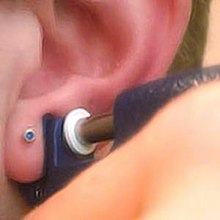
A lip piercing is a type of body piercing that penetrates the lips or the area surrounding the lips, which can be pierced in a variety of ways.

A pipette is a type of laboratory tool commonly used in chemistry and biology to transport a measured volume of liquid, often as a media dispenser. Pipettes come in several designs for various purposes with differing levels of accuracy and precision, from single piece glass pipettes to more complex adjustable or electronic pipettes. Many pipette types work by creating a partial vacuum above the liquid-holding chamber and selectively releasing this vacuum to draw up and dispense liquid. Measurement accuracy varies greatly depending on the instrument.

A syringe is a simple reciprocating pump consisting of a plunger that fits tightly within a cylindrical tube called a barrel. The plunger can be linearly pulled and pushed along the inside of the tube, allowing the syringe to take in and expel liquid or gas through a discharge orifice at the front (open) end of the tube. The open end of the syringe may be fitted with a hypodermic needle, a nozzle or tubing to direct the flow into and out of the barrel. Syringes are frequently used in clinical medicine to administer injections, infuse intravenous therapy into the bloodstream, apply compounds such as glue or lubricant, and draw/measure liquids. There are also prefilled syringes.

A navel piercing is a type of piercing that penetrates the skin of the navel. It is most commonly located on the upper fold of skin but can also be affected underneath or around the edges of the navel. Healing usually takes around 6–12 months but varies person-to-person due to differences in physiology.
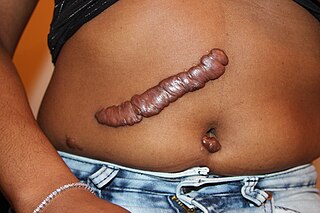
Keloid, also known as keloid disorder and keloidal scar, is the formation of a type of scar which, depending on its maturity, is composed mainly of either type III (early) or type I (late) collagen. It is a result of an overgrowth of granulation tissue at the site of a healed skin injury which is then slowly replaced by collagen type I. Keloids are firm, rubbery lesions or shiny, fibrous nodules, and can vary from pink to the color of the person's skin or red to dark brown in color. A keloid scar is benign and not contagious, but sometimes accompanied by severe itchiness, pain, and changes in texture. In severe cases, it can affect movement of skin. In the United States keloid scars are seen 15 times more frequently in people of sub-Saharan African descent than in people of European descent. There is a higher tendency to develop a keloid among those with a family history of keloids and people between the ages of 10 and 30 years.

An earring is a piece of jewelry attached to the ear via a piercing in the earlobe or another external part of the ear, or, less often, by some other means. Earrings have been worn by people in different civilizations and historic periods, often with cultural significance.
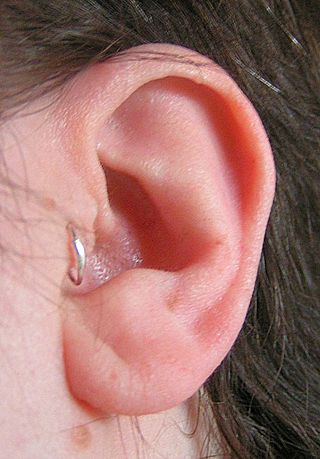
A tragus piercing is the perforation of the tragus, which projects immediately in front of the ear canal, for the purpose of inserting and wearing a piece of jewelry. The piercing itself is usually made with a small gauge hollow piercing needle, and typical jewelry would be a small diameter captive bead ring or small gauge post style piercing jewelry. A related piercing is known as the antitragus piercing.
In modern Western body piercing, a wide variety of materials are used. Some cannot be autoclaved, and others may induce allergic reactions, or harbour bacteria. Certain countries, such as those belonging to the EU, have legal regulations specifying which materials can be used in new piercings.
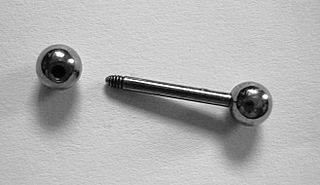
Barbell style piercing jewelry is composed of a straight bar with a bead on each end, one or both beads unscrewable for removal and/or changing of the beads. Often one of the beads is fixed, either via epoxy or welding, so that only one bead is used to install or remove the jewelry. Barbell threads are usually right-handed.
Scalpelling is a body art procedure similar to body piercing for the creation of decorative perforations through the skin and other body tissue, and is most commonly used as a replacement for or enhancement of ear piercing. Whereas piercing is typically performed with a hollow piercing needle or an ear piercing instrument, scalpelling is performed by using a scalpel to cut a slit into the skin. Unlike dermal punching, no flesh is removed. The technique can immediately produce holes with a larger diameter than can be achieved by piercing. This is a more rapid means of accommodating larger gauge jewellery than stretching, a technique whereby piercings are enlarged by inserting gradually larger jewellery. Scalpelling is performed to quickly achieve a large-gauge piercing, when scar tissue is preventing further stretching, if tissue has thinned to the point where further stretching could cause it to break, or to combine two closely placed piercings into one hole.
Stretching, in the context of body piercing, is the deliberate expansion of a healed piercing for the purpose of wearing certain types of jewelry. Ear piercings are the most commonly stretched piercings, with nasal septum piercings, tongue piercings and lip piercings/lip plates following close behind. While all piercings can be stretched to some degree, cartilage piercings are usually more difficult to stretch and more likely to form hypertrophic scars if stretched quickly. Dermal punching is generally the preferred method for accommodating larger jewelry in cartilage piercings.
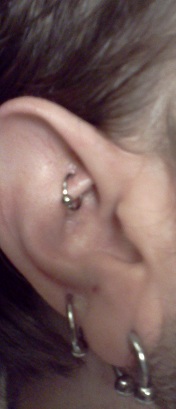
A rook piercing is a perforation of the antihelix of the ear for the purpose of wearing jewelry. It is located just above the tragus on the ridge between the inner and outer conch with the piercing passing from the underside to the top of this ridge, differing from many ear piercings that essentially span between a "front" and "back" surface. Erik Dakota, a well known professional piercer and the individual responsible for originating and popularizing the rook piercing, is said to have named this modification after a shortened version of his first name. The piercing was first named in issue #4 of the magazine Body Play and Modern Primitives Quarterly around 1992 alongside the first printed reference to the industrial piercing, then termed "industrial ear project".

Piercing migration is the process that occurs when a body piercing moves from its initial location. This process can be painful or go unnoticed, until it has progressed. Given enough time, a ring may migrate entirely outside of the skin, although it may only migrate a small amount and come to rest.

The human earlobe, the lower portion of the outer ear, is composed of tough areolar and adipose connective tissues, lacking the firmness and elasticity of the rest of the auricle. In some cases the lower lobe is connected to the side of the face. Since the earlobe does not contain cartilage it has a large blood supply and may help to warm the ears and maintain balance. However, earlobes are not generally considered to have any major biological function. The earlobe contains many nerve endings, and for some people is an erogenous zone.

An orbital piercing is a combination of two ear piercings connected by one piece of jewelry. Usually located in the helix region of the ear, an Orbital Piercing can be done anywhere on the body including your earlobes. The piercing uses a hoop, and is not to be confused with an industrial piercing, a conch piercing or double cartilage piercing.
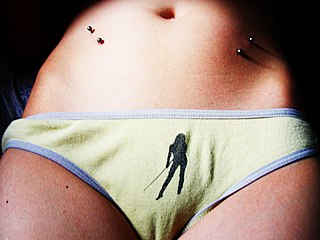
A hip piercing is a piercing in the pelvic area through the skin near the hip bone. Hip piercings are often done in couplets with one on each hip, but it is not unusual to see only one. Hips piercing are a type of surface piercing. Microdermals or skin divers can be implanted in the hip area to give a similar appearance.
A cartilage piercing can refer to any area of cartilage on the body with a perforation created for the purpose of wearing jewelry. The two most common areas with cartilage piercings are the ear and the nose. Many people outside of the body modification community often informally use the term "cartilage piercing" to refer a helix piercing. The cartilage ear piercing is known to be more sore than the lobe as in the cartilage there is less blood so it takes longer to heal.

A plug, in the context of body modification, is a short, cylindrical piece of jewelry commonly worn in larger-gauge body piercings. Modern western plugs are also called flesh tunnels. Because of their size—which is often substantially thicker than a standard metal earring—plugs can be made out of almost any material. Acrylic glass, metal, wood, bone, stone, horn, glass, silicone or porcelain are all potential plug materials.

Body piercing, which is a form of body modification, is the practice of puncturing or cutting a part of the human body, creating an opening in which jewelry may be worn, or where an implant could be inserted. The word piercing can refer to the act or practice of body piercing, or to an opening in the body created by this act or practice. It can also, by metonymy, refer to the resulting decoration, or to the decorative jewelry used. Piercing implants alter the body and/or skin profile and appearance. Although the history of body piercing is obscured by popular misinformation and by a lack of scholarly reference, ample evidence exists to document that it has been practiced in various forms by multiple sexes since ancient times throughout the world. Body piercing can be performed on people of all ages, although most minors are only permitted to have earlobe piercings.
Ear piercing is one of the oldest forms of body modification. It occurs when holes are created on the ear lobes or cartilage to allow the insertion of decorative ornaments, such as earrings. Ear piercing in children has been around for centuries as part of ritualistic and cultural traditions but has continued to become a worldwide mainstream fashion statement. It is extremely common in Nigeria, India, Brazil and Hispanic countries.

